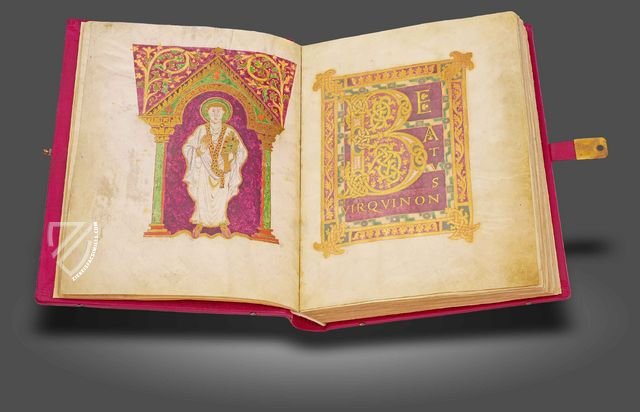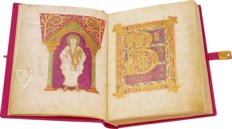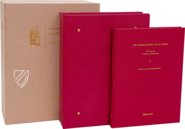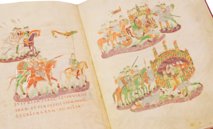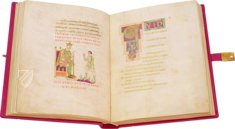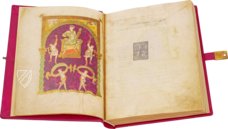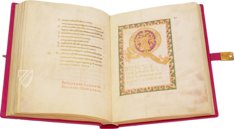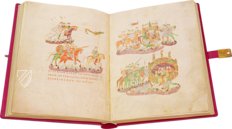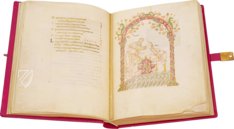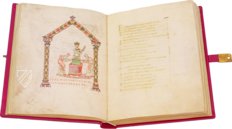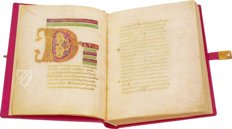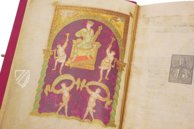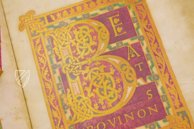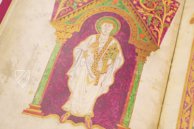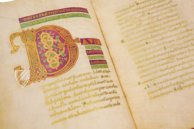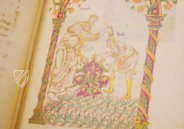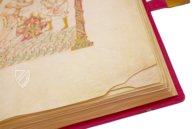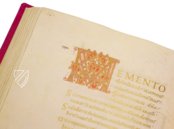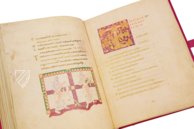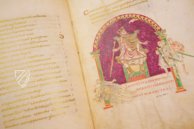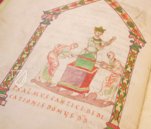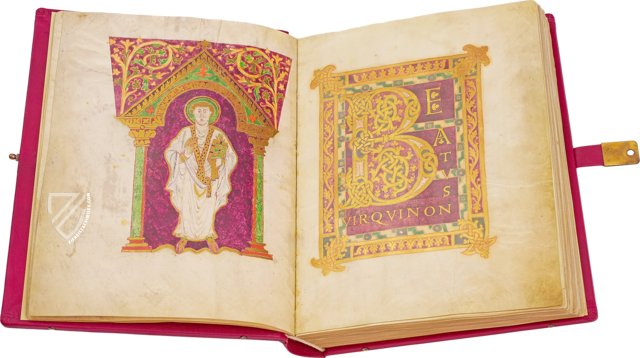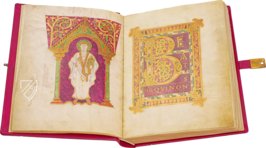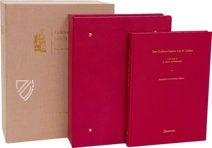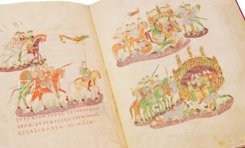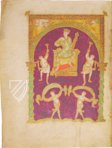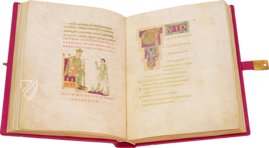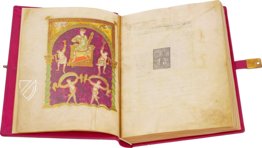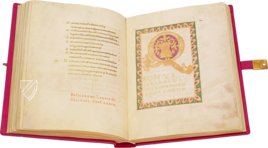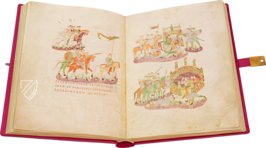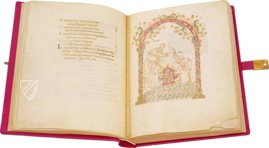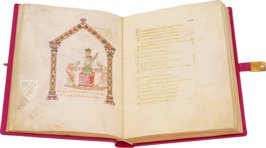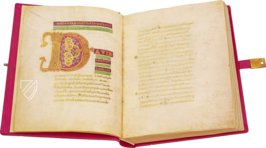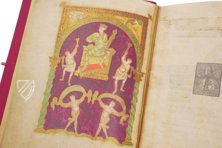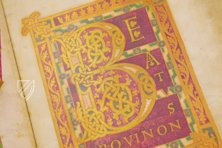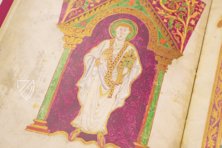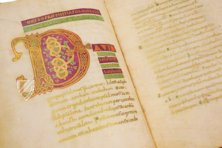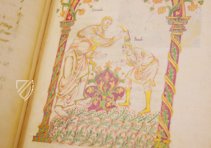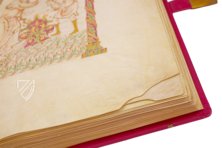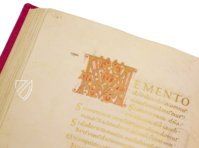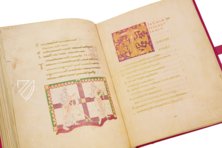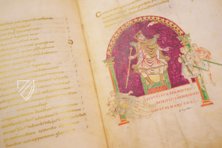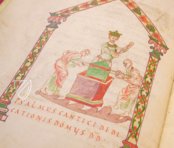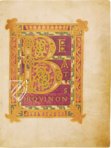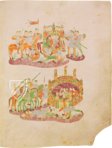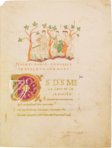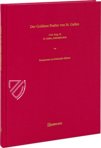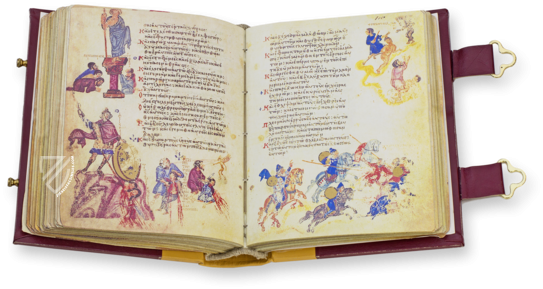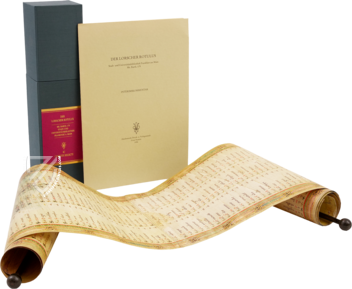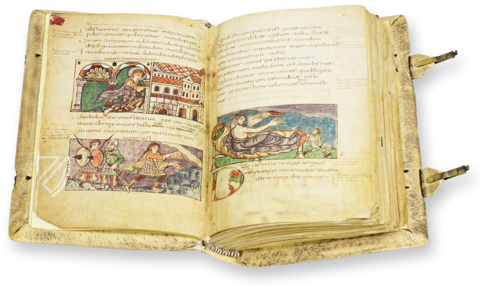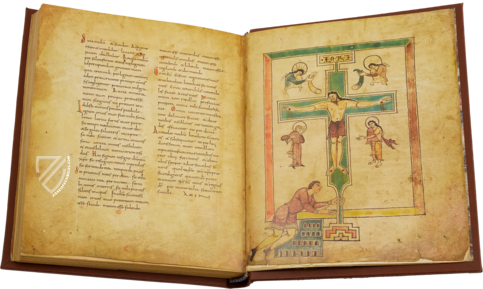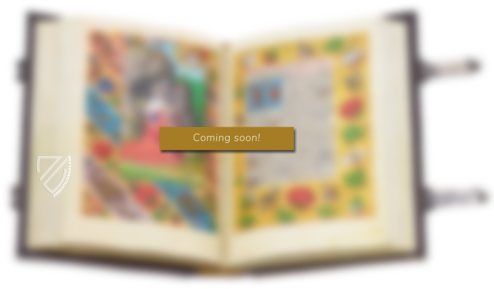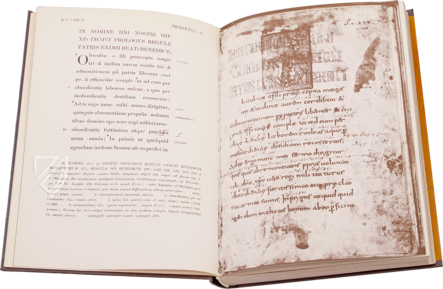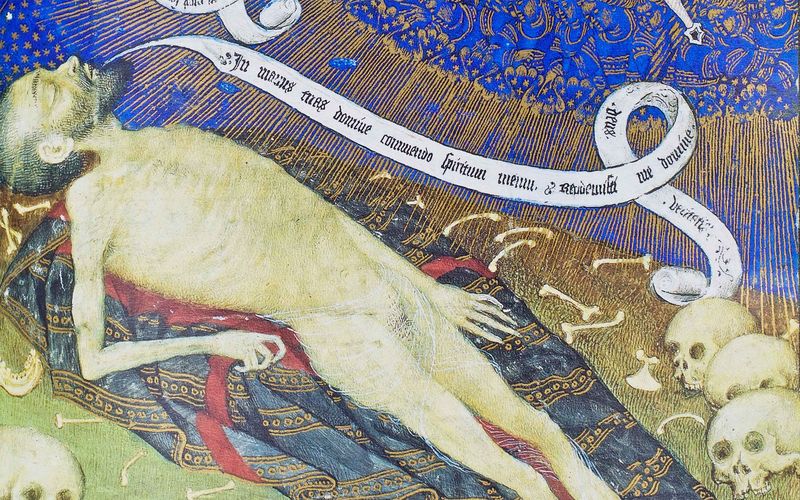Golden Psalter of St. Gall
This Psalterium aureum is a late Carolingian masterpiece of extraordinary splendor. Begun in Soissons in the circle of Louis of Germany, the codex was completed and elaborately illuminated in the famous scriptorium of St. Gall at the end of the 9th century. While the psalms shine almost entirely in gold, the expressive miniatures attract the eye by means of luminous colors such as purple and minium. The Old Testament scenes also give us a glimpse of the early medieval world in the East Frankish Empire. The manuscript's good state of preservation is also exceptional since it has never been departed from its place of origin and is still kept today in the Abbey Library of St. Gall.
Golden Splendor From More Than 1100 Years Ago
The work on the Golden Psalter of St. Gall probably began in a scriptorium in Soissons – possibly in the circle of the East Frankish king and grandson of Charlemagne Louis of Germany (c. 806–876). Who exactly commissioned this luxurious manuscript is unfortunately not known, especially since it was not completed during this first work phase. The unbound folios arrived around 870/80 at the monastery of St. Gall, which was one of the most influential and important scriptoria in Europe between the 9th and 11th centuries and thus a cultural center of the time. There the manuscript was revised, completed and illuminated in two further work phases (883–888 and between 890 and 900).
A "Psalterium aureum" from St. Gall
It is not without reason that the codex is also called a Psalterium aureum: The Old Testament psalm texts shine entirely in golden Carolingian minuscules, while the tituli were executed in a more monumental-looking Capitalis Rustica of gold or minium. Although the text was initially written in brass ink at Soissons, probably for reasons of cost, this was mostly used to imitate the effect of gold ink. Later, these parts of the text were traced with real gold ink by the St. Gall illuminators, and the missing psalms were also added in gold. This peculiarity gave the golden letters a character all their own, making them appear more yellowish in some places and more greenish in others. The patina, which is more than 1000 years old, contributes to this. This chrysographic masterpiece is completed by numerous large and medium-sized initials made of golden letter bodies decorated with interlace and vegetal ornaments.
Old Testament figures in Carolingian dress
The 17 miniatures, nine of which take up an entire page, were also added in St. Gall. The protagonist of the mostly narrative images is King David, who was not only known as the king of the Israelites and the conqueror of Goliath, but was also attributed the authorship of the Psalms in the Middle Ages. Thus, most of the illuminations depict scenes from David's life. The elaborate late Carolingian painting is characterized both by reminiscences of antiquity and by two-dimensional figures with strong facial expressions and gestures and a vivid color palette dominated by purple, minium, green, and gold. Many of the Old Testament figures are also striking for their Frankish garb, which places them in the time of the Psalter's creation, giving us today a captivating glimpse into the world of the Carolingian early Middle Ages.
A golden treasure of the Abbey Library of St. Gall
With this beyond splendid decoration, the liturgical book probably did not serve for the monks' everyday prayers, but was rather used on high feast days in St. Gall and most likely also displayed for distinguished visitors. Today, after centuries of use, the valuable and exceptionally well-preserved manuscript is still at the place of its creation, in the Abbey on the Steinach, and is now kept in a protective safe as one of the most magnificent treasures in the collection of the Abbey Library.
Codicology
- Alternative Titles
- Goldener Psalter von St. Gallen
Psalterium aureum - Size / Format
- 344 pages / 37.0 × 28.0 cm
- Origin
- Switzerland
- Date
- Ca. 870–900
- Epochs
- Style
- Genre
- Language
- Script
- Carolingian minuscule Rustic capitals
- Illustrations
- 17 splendid miniatures, numerous large decorated initials, golden script
- Content
- Book of Psalms
- Patron
- Presumably from the circle of Louis the German
Golden Psalter of St. Gall
King David in the House of his Wife Michal
Michal was the youngest daughter of King Saul and the first wife of David. She fell in love with him shortly after his victory over Goliath, which her father disapproved of because he saw him as a competitor. Saul initially agreed to the marriage anyway, only to arrange for David to be killed – which did not succeed. After Saul again nearly murdered David with a spear, he fled to the house of his wife, who first gave him shelter and then helped him escape when soldiers searched their home. Remarkably, the miniature shows only the soldiers and David, hidden in the shrine-like house of Michal, whose role in the story is virtually negated in the image. The text passage surrounding the unframed miniature describes the scene and picks up on the luminous minium of the miniature – a skillfull intertwining of text and image.
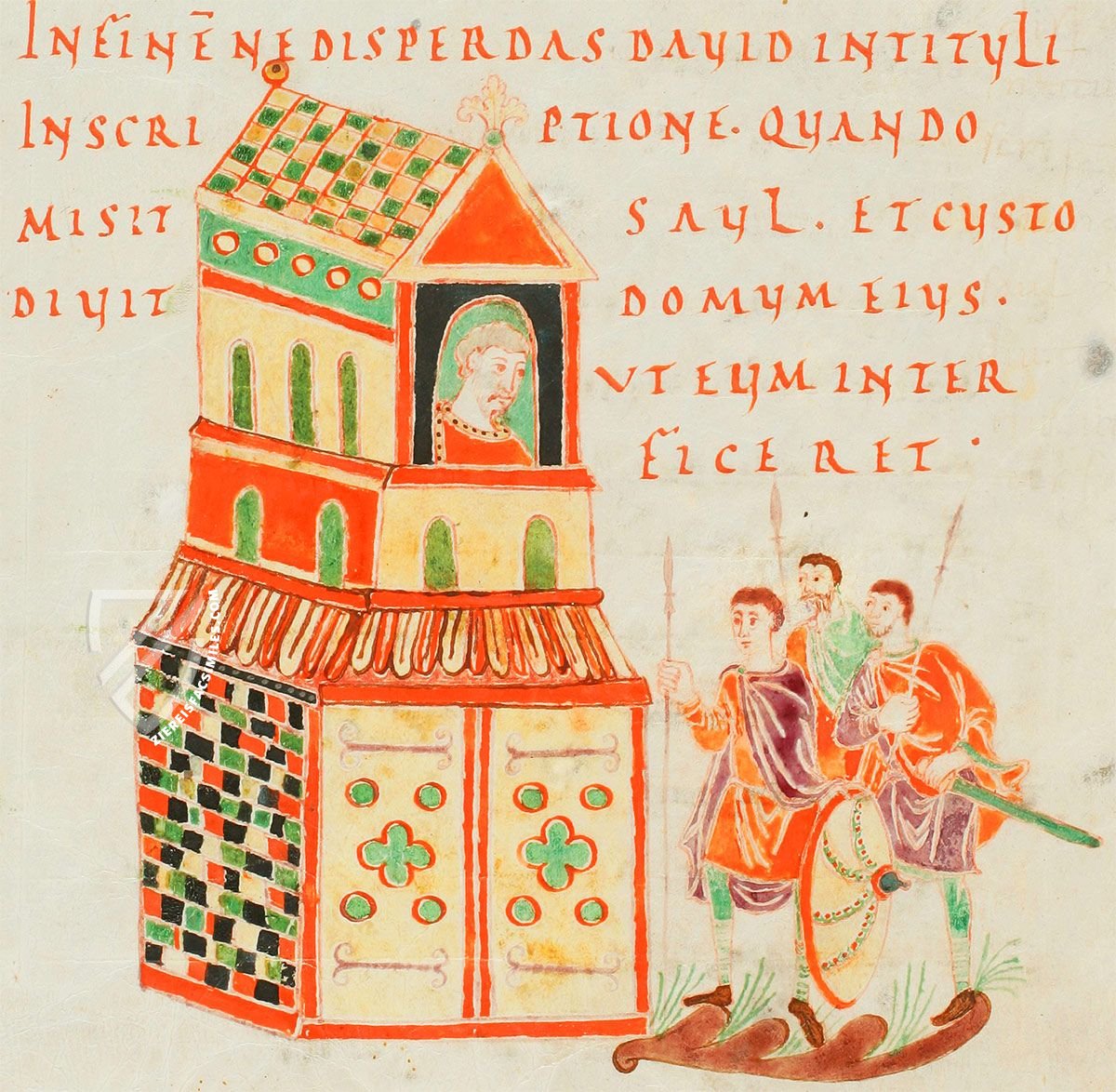
Golden Psalter of St. Gall
David as a Royal Singer
On this page, a round arch on two gorgeous columns provides a view of an exuberant scene: four symmetrically arranged dancers with clappers and veils dance to the melody intoned by the enthroned King David on his cithara. The light coloration and the golden outlines of the figures create an artful contrast to the purple background. The depiction of David as a royal singer with cithara developed into the standard repertoire of Psalter illumination in the early Middle Ages. This tradition was contributed to by this magnificent full-page miniature.
The term cithara was used in the Middle Ages to describe various lyre- and lute-like stringed instruments. The cithara depicted here, which David holds in his left hand, is reminiscent of an upturned lute with its small round sound box at the upper end and the long neck with three strings attached to it. Between his right thumb and forefinger he holds the corresponding plectrum, here a thin golden stick with an angled end.
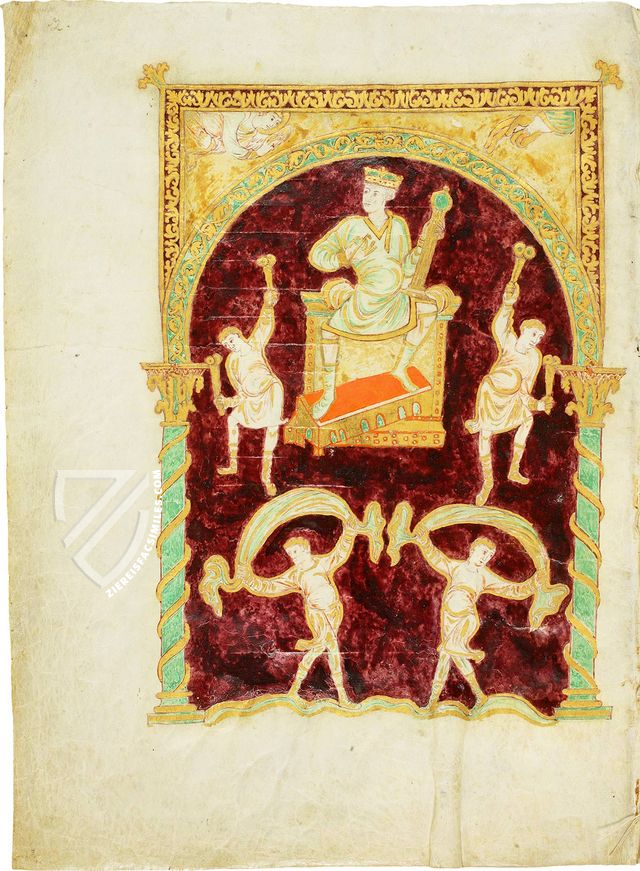
#1 Der Goldene Psalter von St. Gallen
Language: German
- Treatises / Secular Books
- Apocalypses / Beatus
- Astronomy / Astrology
- Bestiaries
- Bibles / Gospels
- Chronicles / History / Law
- Geography / Maps
- Saints' Lives
- Islam / Oriental
- Judaism / Hebrew
- Single Leaf Collections
- Leonardo da Vinci
- Literature / Poetry
- Liturgical Manuscripts
- Medicine / Botany / Alchemy
- Music
- Mythology / Prophecies
- Psalters
- Other Religious Books
- Games / Hunting
- Private Devotion Books
- Other Genres
- Afghanistan
- Armenia
- Austria
- Belgium
- Belize
- Bosnia and Herzegovina
- China
- Colombia
- Costa Rica
- Croatia
- Cyprus
- Czech Republic
- Denmark
- Egypt
- El Salvador
- Ethiopia
- France
- Germany
- Greece
- Guatemala
- Honduras
- Hungary
- India
- Iran
- Iraq
- Israel
- Italy
- Japan
- Jordan
- Kazakhstan
- Kyrgyzstan
- Lebanon
- Liechtenstein
- Luxembourg
- Mexico
- Morocco
- Netherlands
- Palestine
- Panama
- Peru
- Poland
- Portugal
- Romania
- Russia
- Serbia
- Spain
- Sri Lanka
- Sweden
- Switzerland
- Syria
- Tajikistan
- Turkey
- Turkmenistan
- Ukraine
- United Kingdom
- United States
- Uzbekistan
- Vatican City
- A. Oosthoek, van Holkema & Warendorf
- Aboca Museum
- Ajuntament de Valencia
- Akademie Verlag
- Akademische Druck- u. Verlagsanstalt (ADEVA)
- Aldo Ausilio Editore - Bottega d’Erasmo
- Alecto Historical Editions
- Alkuin Verlag
- Almqvist & Wiksell
- Amilcare Pizzi
- Andreas & Andreas Verlagsbuchhandlung
- Archa 90
- Archiv Verlag
- Archivi Edizioni
- Arnold Verlag
- ARS
- Ars Magna
- ArtCodex
- AyN Ediciones
- Azimuth Editions
- Badenia Verlag
- Bärenreiter-Verlag
- Belser Verlag
- Belser Verlag / WK Wertkontor
- Benziger Verlag
- Bernardinum Wydawnictwo
- BiblioGemma
- Biblioteca Apostolica Vaticana (Vaticanstadt, Vaticanstadt)
- Bibliotheca Palatina Faksimile Verlag
- Bibliotheca Rara
- Boydell & Brewer
- Bramante Edizioni
- Bredius Genootschap
- Brepols Publishers
- British Library
- C. Weckesser
- Caixa Catalunya
- Canesi
- CAPSA, Ars Scriptoria
- Caratzas Brothers, Publishers
- Carus Verlag
- Casamassima Libri
- Centrum Cartographie Verlag GmbH
- Chavane Verlag
- Christian Brandstätter Verlag
- Circulo Cientifico
- Club Bibliófilo Versol
- Club du Livre
- CM Editores
- Collegium Graphicum
- Collezione Apocrifa Da Vinci
- Comissão Nacional para as Comemorações dos Descobrimentos Portugueses
- Coron Verlag
- Corvina
- CTHS
- D. S. Brewer
- Damon
- De Agostini/UTET
- De Nederlandsche Boekhandel
- De Schutter
- Deuschle & Stemmle
- Deutscher Verlag für Kunstwissenschaft
- DIAMM
- Droz
- E. Schreiber Graphische Kunstanstalten
- Ediciones Boreal
- Ediciones Grial
- Ediclube
- Edições Inapa
- Edilan
- Editalia
- Edition Deuschle
- Edition Georg Popp
- Edition Leipzig
- Edition Libri Illustri
- Editiones Reales Sitios S. L.
- Éditions de l'Oiseau Lyre
- Editions Medicina Rara
- Editorial Casariego
- Editorial Mintzoa
- Editrice Antenore
- Editrice Velar
- Edizioni Edison
- Egeria, S.L.
- Eikon Editores
- Electa
- Emery Walker Limited
- Enciclopèdia Catalana
- Eos-Verlag
- Ephesus Publishing
- Ernst Battenberg
- Eugrammia Press
- Extraordinary Editions
- Fackelverlag
- Facsimila Art & Edition
- Facsimile Editions Ltd.
- Facsimilia Art & Edition Ebert KG
- Faksimile Verlag
- Feuermann Verlag
- Folger Shakespeare Library
- Franco Cosimo Panini Editore
- Friedrich Wittig Verlag
- Fundación Hullera Vasco-Leonesa
- G. Braziller
- Gabriele Mazzotta Editore
- Gebr. Mann Verlag
- Gesellschaft für graphische Industrie
- Getty Research Institute
- Giovanni Domenico de Rossi
- Giunti Editore
- Graffiti
- Grafica European Center of Fine Arts
- Guido Pressler
- Guillermo Blazquez
- Gustav Kiepenheuer
- H. N. Abrams
- Harrassowitz
- Harvard University Press
- Helikon
- Hendrickson Publishers
- Henning Oppermann
- Herder Verlag
- Hes & De Graaf Publishers
- Hoepli
- Holbein-Verlag
- Houghton Library
- Hugo Schmidt Verlag
- Idion Verlag
- Il Bulino, edizioni d'arte
- ILte
- Imago
- Insel Verlag
- Insel-Verlag Anton Kippenberger
- Instituto de Estudios Altoaragoneses
- Instituto Nacional de Antropología e Historia
- Istituto dell'Enciclopedia Italiana - Treccani
- Istituto Ellenico di Studi Bizantini e Postbizantini
- Istituto Geografico De Agostini
- Istituto Poligrafico e Zecca dello Stato
- Italarte Art Establishments
- Jan Thorbecke Verlag
- Johnson Reprint Corporation
- Josef Stocker
- Josef Stocker-Schmid
- Jugoslavija
- Karl W. Hiersemann
- Kasper Straube
- Kaydeda Ediciones
- Kindler Verlag / Coron Verlag
- Kodansha International Ltd.
- Konrad Kölbl Verlag
- Kurt Wolff Verlag
- La Liberia dello Stato
- La Linea Editrice
- La Meta Editore
- Lambert Schneider
- Landeskreditbank Baden-Württemberg
- Leo S. Olschki
- Les Incunables
- Liber Artis
- Library of Congress
- Libreria Musicale Italiana
- Lichtdruck
- Lito Immagine Editore
- Lumen Artis
- Lund Humphries
- M. Moleiro Editor
- Maison des Sciences de l'homme et de la société de Poitiers
- Manuscriptum
- Martinus Nijhoff
- Maruzen-Yushodo Co. Ltd.
- MASA
- Massada Publishers
- McGraw-Hill
- Metropolitan Museum of Art
- Militos
- Millennium Liber
- Müller & Schindler
- Nahar - Stavit
- Nahar and Steimatzky
- National Library of Wales
- Neri Pozza
- Nova Charta
- Oceanum Verlag
- Odeon
- Orbis Mediaevalis
- Orbis Pictus
- Österreichische Staatsdruckerei
- Oxford University Press
- Pageant Books
- Parzellers Buchverlag
- Patrimonio Ediciones
- Pattloch Verlag
- PIAF
- Pieper Verlag
- Plon-Nourrit et cie
- Poligrafiche Bolis
- Presses Universitaires de Strasbourg
- Prestel Verlag
- Princeton University Press
- Prisma Verlag
- Priuli & Verlucca, editori
- Pro Sport Verlag
- Propyläen Verlag
- Pytheas Books
- Quaternio Verlag Luzern
- Reales Sitios
- Recht-Verlag
- Reichert Verlag
- Reichsdruckerei
- Reprint Verlag
- Riehn & Reusch
- Roberto Vattori Editore
- Rosenkilde and Bagger
- Roxburghe Club
- Salerno Editrice
- Saltellus Press
- Sandoz
- Sarajevo Svjetlost
- Schöck ArtPrint Kft.
- Schulsinger Brothers
- Scolar Press
- Scrinium
- Scripta Maneant
- Scriptorium
- Shazar
- Siloé, arte y bibliofilia
- SISMEL - Edizioni del Galluzzo
- Sociedad Mexicana de Antropología
- Société des Bibliophiles & Iconophiles de Belgique
- Soncin Publishing
- Sorli Ediciones
- Stainer and Bell
- Studer
- Styria Verlag
- Sumptibus Pragopress
- Szegedi Tudomànyegyetem
- Taberna Libraria
- Tarshish Books
- Taschen
- Tempus Libri
- Testimonio Compañía Editorial
- Thames and Hudson
- The Clear Vue Publishing Partnership Limited
- The Facsimile Codex
- The Folio Society
- The Marquess of Normanby
- The Richard III and Yorkist History Trust
- Tip.Le.Co
- TouchArt
- TREC Publishing House
- TRI Publishing Co.
- Trident Editore
- Tuliba Collection
- Typis Regiae Officinae Polygraphicae
- Union Verlag Berlin
- Universidad de Granada
- University of California Press
- University of Chicago Press
- Urs Graf
- Vallecchi
- Van Wijnen
- VCH, Acta Humaniora
- VDI Verlag
- VEB Deutscher Verlag für Musik
- Verlag Anton Pustet / Andreas Verlag
- Verlag Bibliophile Drucke Josef Stocker
- Verlag der Münchner Drucke
- Verlag für Regionalgeschichte
- Verlag Styria
- Vicent Garcia Editores
- W. Turnowski Ltd.
- W. Turnowsky
- Waanders Printers
- Wiener Mechitharisten-Congregation (Wien, Österreich)
- Wissenschaftliche Buchgesellschaft
- Wissenschaftliche Verlagsgesellschaft
- Wydawnictwo Dolnoslaskie
- Xuntanza Editorial
- Zakład Narodowy
- Zollikofer AG

